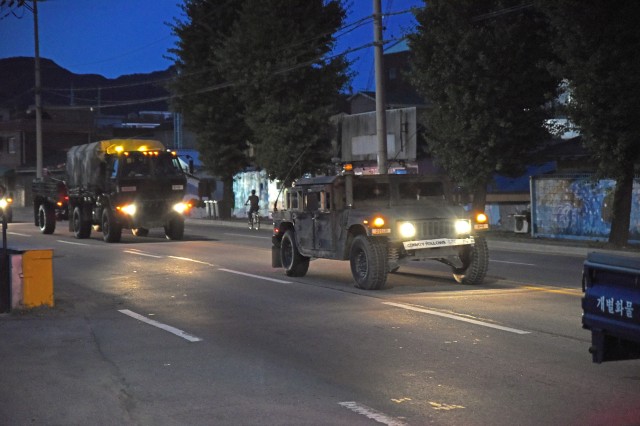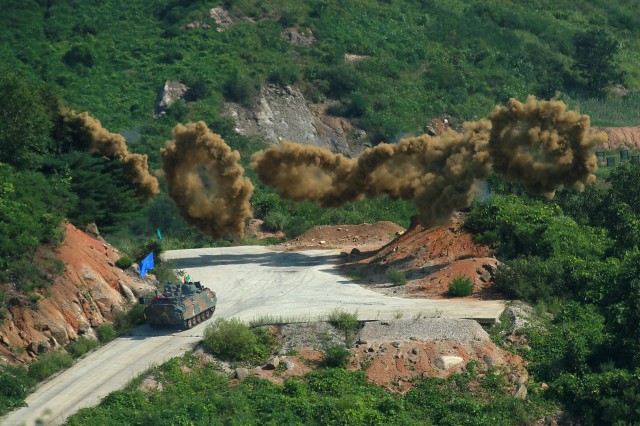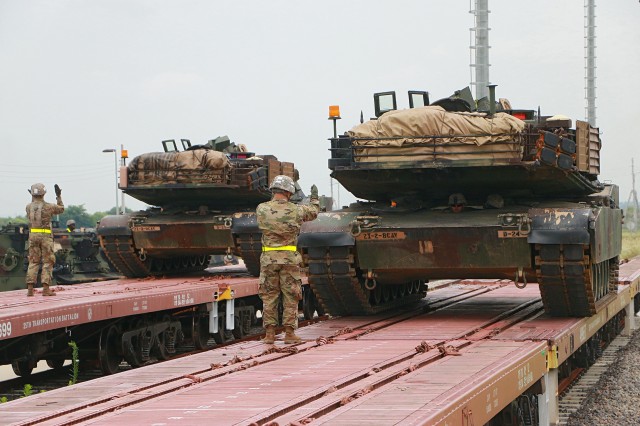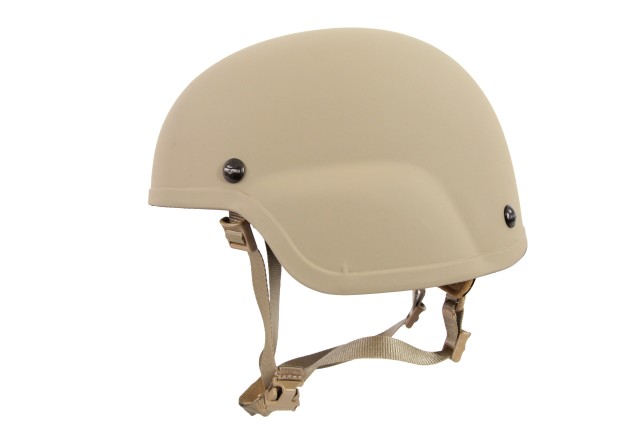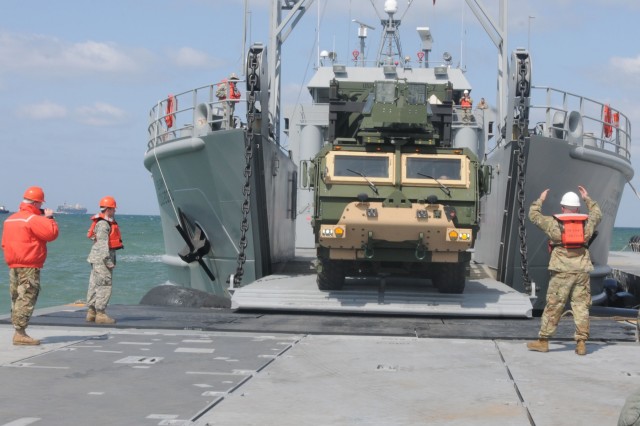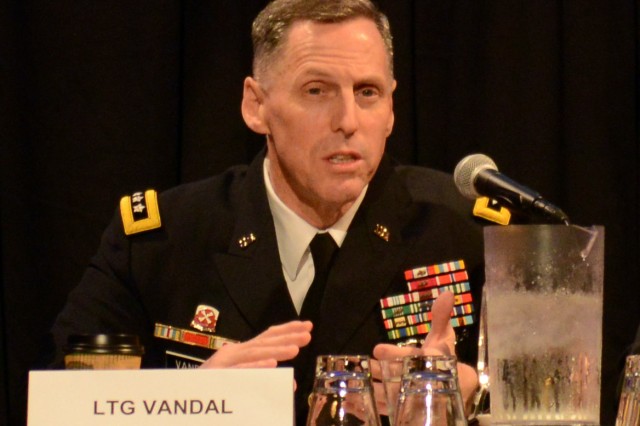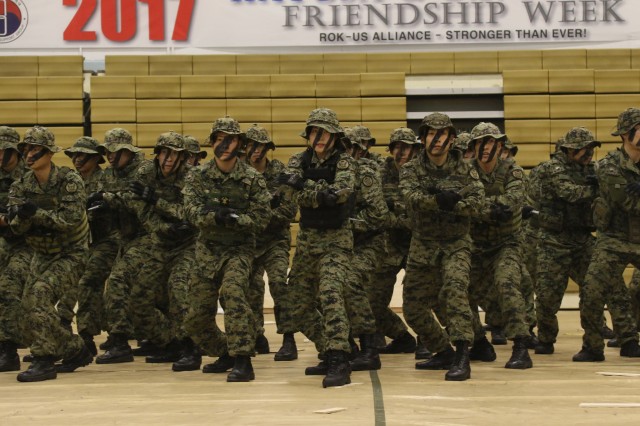Eighth Army ready to 'fight tonight' alongside Korean partners
By David VergunMay 31, 2017
1 / 3 Hide Caption – U.S. Soldiers and Marines wait on the Trident Pier in Pohang, South Korea, to offload tactical vehicles from a U.S. Army Landing Craft Utility 2020 ship during Operation Pacific Reach 2017, April 10. Service members from the Army, Navy and Marines came together to participate in the combined joint exercise that tested Logistics Over-the-Shore, inland waterway and Air Terminal Supply Point capabilities. (Photo Credit: Sgt. Quanesha Deloach)
VIEW ORIGINAL
2 / 3 Hide Caption – Lt. Gen. Thomas Vandal, commander, Eighth Army/chief of staff, Republic of Korea -- U.S. Combined Forces Command, speaks at The Association of the United States Army Institute of Land Warfare-sponsored "Land Forces in the Pacific: Advancing Joint and Multi-National Integration," May 24, 2017, in Honolulu, Hawaii. (Photo Credit: David Vergun)
VIEW ORIGINAL
3 / 3 Hide Caption – Eighth Army celebrates KATUSA Friendship Week 2017 with an Opening Ceremony at Yongsan Garrison, South Korea, April 17. During the ceremony, there were special performances from the Honor Guard and Special Force of the ROK. (Photo Credit: Pv2. Yang, Hyungyu)
VIEW ORIGINAL
WASHINGTON (Army News Service) -- Eighth Army is ready to fight tonight. It's also ready to fight tonight beside its Republic of Korea, or ROK brethren in a combined endeavor, said Lt. Gen. Thomas Vandal.
Vandal, commander, Eighth Army/chief of staff, Republic of Korea -- U.S. Combined Forces Command, spoke at the Association of the United States Army Institute of Land Warfare-sponsored "Land Forces in the Pacific: Advancing Joint and Multi-National Integration," May 24.
COMBINED COMMANDS
The U.S.-ROK team is much more than just a combined training effort, Vandal said. Members of both armies are being integrated at the headquarters level.
Eighth Army's major subordinate command consists of the U.S. Army's only major combined fighting force, the 2nd Infantry Division/ROK-U.S. Combined Division, or RUCD, he said.
Vandal said he was in on the planning of that effort back in 2013, when he was the commander of 2nd Inf. Div., his previous assignment.
By 2015, the combined division was activated and today, "hand-picked, ROK officers, the best-of-the-best, are an integral part of the staff," he said. "Now, we're adding ROK staff non-commissioned officers as well."
Besides that integration, the combined division has built a close training relationship with the 8th ROK Inf. Div., a unit that they would fight alongside, should the "O plan" get executed, he said, meaning the wartime operations plan.
Other efforts to combine are also underway.
"Eighth Army is going to become a combined ground component command that will be established in 2018," Vandal said, noting that he will then become the deputy ground component commander, working for a ROK four-star.
While those integration efforts involve the headquarters staff, there is also an integration effort underway involving the Weapons of Mass Destruction Elimination Task Force, he said.
Here's how the WMD Elimination TF works, he said. As rotational brigade combat teams flow into theater, they will be operationally controlled by either the RUCD or by the 17th ROK Inf. Div. Elements from those BCTs will in turn form the WMD Elimination TF. This task force will be ROK-US integrated down to the battalion level and below, "providing the synergy of the best of both nations' armies."
The U.S. will provide the technology enablers and part of the maneuver forces for the WMD Elimination TF, he explained. The ROK contribution will be its maneuver forces, "particularly light infantry that are so beneficial to conducting these mission sets for WMD elimination."
LARGE-SCALE EXERCISES
"I would say our exercise [operations tempo] is the highest in the Army," Vandal said, "and the reason I say that is because we must be ready to fight tonight."
Two of the large exercises, he noted, are Key Resolve, held each March and Ulchi Freedom Guardian, or UFG, held each August. "They're probably the largest exercises in the U.S. Army."
Regarding UFG, it includes some 400,000 ROK government personnel all the way up to the cabinet level, plus the some 40,000 military participants, he said.
"It's a whole-of-government approach to their national security and they are all in," he said.
Besides those two exercises, there are numerous smaller ones, he added.
At a higher level than Eighth Army, Gen. Vincent K. Brooks, commander of United Nations Command, Combined Force Command and U.S. Forces Korea, is working to expand UN participation in exercises, Vandal said.
Of the 17 sending states which fought in the Korean War, "all participate and are committed to the UN Command," he said. "So we are looking at how to expand their participation in future exercises."
Last year during UFG, for example, the Canadians for the first time provided one of their divisions, he noted. If war were to break out, that division would be part of I Corps, but under the operational control of the 3rd ROK Army.
Vandal said that over the years, there's been an increase in units and sending state participation and that in the future, he expects there will be further increases.
MULTI-DOMAIN BATTLE
Multi-domain battle, or MDB, took up a large portion of LANPAC discussions.
The MDB concept encourages units to engage the enemy in all domains -- air, sea, land, cyber, space -- in the context of a joint, multinational combined effort, Brown explained.
"We are doing a lot of that already," Vandal said of MDB, providing three examples.
First, during this month's Warrior Strike, a counter-WMD exercise, the U.S. Army flew a WMD Elimination TF onto a ROK amphibious carrier. From there, the unit did an air assault onto a suspected WMD underground facility.
The exercise involved naval, ground and air components of the U.S. and ROK forces. "You can well imagine the complexity of doing something like that," he said, adding that the exercise was realistic and would be a top priority should a real situation unfold.
Second, there was a recent maritime counter special operations force exercise that integrated Apache helicopters from the 2nd Combat Aviation Brigade with the U.S. naval component from 7th Fleet, special forces and a ROK air component. That too was complex, he said.
Third, the ROK and U.S. Army, Air Force, Navy and Marine Corps came together to test combined joint logistics over-the-shore, involving the use of rail, inland waterways and air terminal supply point capabilities. That exercise focused on sustaining the combined force, he said.
The exercise included bringing in a floating dock and establishing an expeditionary port so U.S. Army and Marine materiel could be brought in, he said.
"The piece that needs to be worked harder is the cyber and the space integration to make all five domains integrated. That's the way ahead," he added.
HUMPHREYS GETTING FAT
"Transformation of Eighth Army and arguably the transformation for the whole peninsula for U.S. Forces Korea is the most dramatic since 1953," the end of the fighting during the Korean War, Vandal said.
Not only are units combining, there is also a huge base consolidation going on, with the big recipient being U.S. Army Garrison Humphreys.
This consolidation isn't exactly new, he said. It's been going on for about 10 years and involves moving Soldiers, Army civilians, contractors and families from some 120 installations, most north of the Han River which runs through the capital of Seoul, and moving them into Camp Humphreys farther south.
Eighth Army and U.S. Forces Korea in Yongsan are included in that move, which costs $10.7 billion, 92 percent of which is being paid by the ROK government, he said.
"We've essentially tripled the size of Camp Humphreys," he said, and by 2020, the transfers should be complete with about 42,000 personnel on post.
Eighth Army is in the process of moving there now and its new should be stood up by July 13. U.S. Forces Korea and RUCD will be moved there by January 2018, he said.
Vandal called Camp Humphreys "the crown jewel of overseas assignments" for Soldiers and families, meaning good quality of life and excellent family housing and facilities like a post exchange and commissary. He added that it's "absolutely the best overseas installation I've seen and probably the largest."
A benefit of the move, he said, is force protection. With everyone in one place, it will be quicker to evacuate family members should the need occur.
Lastly, Vandal said that the expansion of Camp Humphreys is "a commitment to the alliance;" a fiscal commitment by the South Koreans and a military commitment by the U.S. to provide stability and security not just for Korea but for the entire region.
NURTURING THE ALLIANCE
For Soldiers of the Eighth Army, "the center of gravity in Korea is the alliance and each one of us has a responsibility, from private to general officer to help nurture that alliance," Vandal emphasized.
"We do it through combined training. We do it through relationship building. We do it through community interaction. So collectively, it helps us build a strong, healthy relationship," he continued.
That relationship is encapsulated in the Korean phrase that the U.S. Soldiers have adopted: "Kapshi Kapshida," he said, which means "Let's Go Together."
Lastly, Vandal spoke to his Soldiers: "You serve here with a sense of purpose. You see a threat. You look at it every single day. You are focused on that threat and because of that sense of purpose, you are very much focused on being ready to fight tonight, from the youngest private to every general officer."

